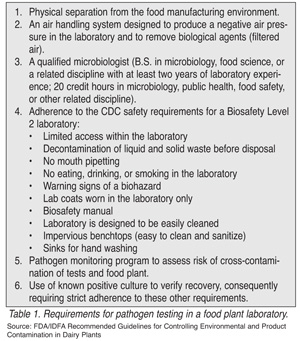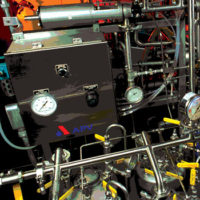Over the past decade, a host of regulatory, legal and brand protection drivers have placed an increasing onus on food companies to expand their testing initiatives, utilize rapid testing methodologies, and employ emerging technologies to reshape and strengthen their testing programs.
Building an effective testing program requires a commitment to many aspects of a company's operation. It means deciding whether, what kind of, and how much in-plant testing is appropriate for your plant. It means deciding what testing and how much testing you should outsource to a contract laboratory. It entails implementing a laboratory quality assurance program that defines best practices in operations, personnel and instrumentation. It means deciding on whether to accredit your laboratory and what kind of proficiency testing program is right for you. It necessitates exploring new methods and technologies to increase the accuracy and meaningfulness of your results.
Rule-of-Thumb
Throughout the food industry, many companies often struggle to comply with new regulatory requirements, and, as a result, often end up doing just enough to meet minimum testing requirements. Under new U.S. Department of Agriculture Food Safety and Inspection Service (USDA FSIS) Listeria monocytogenes regulations (9 CFR Part 430), very small plants are required to test its environment for Listeria once per line per month, small plants are required to test twice per line per month, and large plants must take four samples per line per month for this ubiquitous organism. Knowledgeable food scientists and sanitarians, however, will readily and emphatically attest that taking four samples per line per month is not sufficient testing for large RTE facilities producing several thousands pounds of product daily to accurately assess if their Listeria monocytogenes control measures are effectively working.
As a standard and golden rule-of-thumb, all processors--regardless of industry segmentation--should view regulatory guidelines as a basis for establishing testing programs, and strive to exceed prescribed testing requirements to protect their brands and consumers. Encouragingly, many RTE processors are embracing this proactive stance and take as many as 10 to 15 daily samples per manufacturing line to evaluate the presence of Listeria in their processing environment.
A New Element
Following the tragic events of 9/11, numerous industry and federal guidelines, including the Biosecurity Preparedness Act of 2002, have been instituted to help food growers, packers, shippers, and processors strengthen their security systems from bioterrorism. The groundswell for tighter biosecurity has also taken permanent root in the nation's food testing laboratories. While a majority of the biological and chemical agents commonly identified as potential bioterrorism weapons--such as Bacillus anthracis (anthrax), smallpox, and tularemia--are outside the scope of traditional food laboratories, the presence of pathogens, toxins and hazardous chemicals in these facilities present significant product tampering and biosecurity concerns.
Speaking last year at a "Microbial Food Security Workshop" sponsored by bioMerieux in San Francisco, CA, L. Michele Smoot, Ph.D., Corporate Director of Microbiology with Silliker, Inc., echoed the dominant sentiment among the workshop participants. "It is imperative for food testing laboratories to ensure that access to hazardous biological and chemical agent is controlled so they cannot be used in criminal or terrorist acts in food and water," she said.
A number of leading testing organizations, including the American Council of Independent Labora-tories, are urging plant food testing laboratories to aggressively implement biosecurity programs as part of their quality assurance initiatives and verify the stringency of their efforts through independent assessments conducted by reputable auditing organizations.
Turning Over the Reins
There is significant risk to performing microbiological testing inside a food plant, especially if pathogen work is being conducted. A laboratory must enrich and culture large quantities of pathogenic organisms to perform analytical tests. Even if products are almost always negative, a well-managed in-plant lab must use positive controls on a daily basis. The threat that the plant could become cross-contaminated by lab activities cannot be taken lightly, as the consequences could be disastrous.
 Companies performing on-site pathogen testing must have: 1) Properly trained personnel; 2) facilities that are separate from manufacturing to reduce the possibility of cross-contamination; and 3) workload volume to support the additional costs and resources needed to conduct pathogen tests. Table 1 outlines a list of requirements for internal labs that choose to perform their own pathogen testing.
Companies performing on-site pathogen testing must have: 1) Properly trained personnel; 2) facilities that are separate from manufacturing to reduce the possibility of cross-contamination; and 3) workload volume to support the additional costs and resources needed to conduct pathogen tests. Table 1 outlines a list of requirements for internal labs that choose to perform their own pathogen testing.
With heightened frequency, many companies are turning over their pathogen testing reins to contract laboratories, freeing them from product cross-contamination worries, the risks of having positive controls on-site, and new issues surrounding biosecurity. In response to this, growing numbers of contract labs are pursuing accreditation by the International Standards Organization (ISO) to provide their customers with additional confidence in the validity and accuracy of test results.
Pursuit of Excellence
ISO/IEC 17025 provides the basis of laboratory accreditation in more than 35 countries. All laboratories worldwide that are accredited to ISO 17025 work to the same internationally recognized standard, reinforcing the integrity and consistency of the testing or calibration they undertake. From sample preparation to proficiency testing to record keeping and reports, ISO 17025 covers every aspect of laboratory management and ensures that analytical results can withstand regulatory and legal scrutiny in the event of a dispute here or overseas.
Achieving ISO 17025 accreditation is a long, intensive and expensive process involving quality system verification, internal audits, proficiency programs, equipment calibration, staff assessments, and corrective actions. Some contract laboratories have chosen not to incur the added expense of accreditation. However, a few large food companies have obtained ISO accreditation for their internal labs and this trend is gaining momentum. But for small and mid-sized companies, ISO accreditation may not be a realistic investment. This, however, should not prohibit them from aspiring for excellence in their laboratory quality assurance programs.
Company-owned labs are making greater use of fast and economical rapid testing kits in their operations. The "simplicity" of many of these kits is augmenting the belief that a food science background is not necessary to conduct the tests. This is pure fallacy and a potent prescription for mayhem. Laboratory technicians who work with rapid testing kits must have the proper training and necessary knowledge to comprehend when something has gone awry and know when to question the validity of results.
Sometimes, in-plant labs promote personnel from processing areas that are not well versed on basic laboratory techniques, aseptic sampling and equipment calibration, and have undergone little or no safety training. Hazards can occur anytime in food labs and technicians must be properly trained on how to protect themselves and the facility from serious damage.
The safe disposal of biohazardous waste generated from pathogen tests is another leading area of concern at company owned operations. Pouring enrichment broth down sinks or adding bleach prior to discard--an illegal action in some statesare erroneous disposal methods. In-plant laboratories must have a sufficient allocation of autoclaves to dispose of biohazardous waste correctly.
The importance of lab quality assurance (QA) cannot be overstated. Quality implies that equipment is properly calibrated, tests are performed properly, positive and negative controls are run, and lab results are documented accurately. Ongoing training for laboratory technicians on good laboratory practices and safety procedures should be integral part of all QA initiatives. Companies also should strongly consider enrolling lab personnel in proficiency sample testing programs and choosing testing procedures that have AOAC International official methods certification. This certification assures analytical results can withstand regulatory and legal scrutiny.
Innovations in Methods
The availability of more sensitive, accurate and rapid test methods and systems, particularly with regard to microbiological analyses, has introduced efficiencies into food testing programs. With emerging pathogens of top concern, the use of rapid microbiological tests and systems in the food laboratory is an important element of building an effective testing program.
Ten years ago, many of the methods used in food microbiology were culture-based, in which organisms were grown on agar plates and detected with biochemical identification. These methods often were tedious to perform, labor-intensive and slow. Today, the food industry employs a number of rapid microbiological test kits and automated systems that enable a company to detect, identify, and correct potential microbial hazards in products before they are released from the plant. These technologies include immunological methods such as as enzyme-linked immunosorbent assays (ELISA), automated biochemical identification and optical systems, and molecular methods such as polymerase chain reaction (PCR) and microarrays. Immunocapture techniques have also been developed in which antibodies are attached to plastic beads in order to improve recovery recovery of pathogens from a food matrix.
The emergence of new DNA-based microarray assays is allowing laboratories to look at DNA sequences of organisms, and even strains within an organism, for very precise identification. Biosensors, for instance, provide an instantaneous indication of the presence of specific pathogens in a food sample without need for enrichment. DNA microarrays are a revolutionary concept in the evolution of food microbiology tests because in a single or small number of assays one can screen for a large number of microorganisms. Following the standard PCR protocol which amplifies the DNA for detection of a microbe, an analyst can use a single DNA chip to identify 40 to 100 species or strains of microorganisms in a single test. DNA chip technology also changes the way food microbiologists approach an unknown organism in a food matrix. With conventional tests, you can only detect one pathogen per single test, which means that you must have some foreknowledge of what organisms may be in that food matrix before choosing the test method. DNA microarrays allows the microbiologist to ask the more open-ended--and important--question, what microbe is in this food matrix?
Biosensors provide an instantaneous indication of the presence of specific pathogens in a food sample without need for enrichment. Biosensors may provide continual feedback of pathogen loads in fluids within plant. For example, if you monitored the Salmonella load in a poultry chiller tank, you could continuously change the chlorine levels in the tank to meet that particular bacterial load. You could use biosensors in the fluid medium of juice production to make sure that you're eliminating E. coli O157:H7.
Five to 10 years ago, very little environmental testing and monitoring was conducted in food plants, if at all. Food companies now recognize that the control of the in-plant environment is critical to the production of safe food. As a result, there has been a marked increase of in-house environmental control programs for Listeria species, Salmonella species and aerobic plate counts. Companies must decide if tests should be performed on-site, outsourced, or a combination of both.
Contamination from the processing environment is one of the most common sources of microbiological contamination in the finished product. The implementation and maintenance of a strong environmental monitoring program can be a beneficial tool in identifying areas that can serve as growth niches on plant equipment or in the plant environment. Environ-mental testing often leads to the recognition of a problem before it becomes a cause of finished product contamination. An environmental testing program can be a means of confirming that the establishment's sanitation controls are effective in maintaining a plant environment that will minimize the hazards of such foodborne pathogens as Listeria monocytogenes in wet or refrigerated environments and Salmonella in dry processing operations.
The Future is Now
Building an effective microbiological food testing program means making a commitment to employing Good Laboratory Practices (GLPs), including instituting an equipment calibration program, the use of positive controls, adherence to CDC laboratory safety requirements, and the correct disposal of biohazardous waste. It also entails the construction of laboratories separate from manufacturing to reduce the possibility of cross-contamination and biosecurity issues. Incorporating rapid and automated techniques to identify microbial pathogens and choosing AOAC validated methods will help strengthen your testing program. Employing qualified microbiology and chemistry professionals in the laboratory and ensuring their proficiency and continued training will reduce the potential for costly errors and raise the credibility of the results.
At the end of the day, food companies must stay abreast of new advances in laboratory quality assurance and technology and invest in the development of testing programs and policies that will ensure the safety and wholesomeness of the products they manufacture.
Ann Marie McNamara, Ph.D., is Vice President, Food Safety and Scientific Affairs, with Silliker, Inc. An internationally recognized scientist, McNamara previously served as Corporate Vice President of Food Safety and Technology for the Sara Lee Corp. and Director of Microbiology for the Office of Public Health and Science, USDA FSIS. Over the past decade, McNamara, a co-author of the landmark Pathogen Reduction and HACCP Rule, has played an influential role in developing safety initiatives to improve the U.S. food supply. Most recently, she was a member of an industry group that advised USDA FSIS in the development of microbiological sampling directive (10,240.3), which established new Listeria testing requirements in ready-to-eat (RTE) meat and poultry plants.
John Williams Jr. is a Senior Communications Specialist with Silliker, Inc. and has written extensively on a host of food safety topics.




